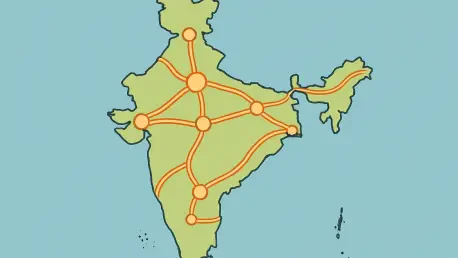Imagine a country where sprawling cities and distant regions are seamlessly linked, where hours-long traffic jams become a relic of the past, and where economic growth accelerates through the veins of modern infrastructure. India is taking monumental strides toward this vision with the recent unveiling of transformative expressway projects that promise to redefine connectivity across urban and rural landscapes. Spearheaded by the central government under Prime Minister Narendra Modi, these initiatives are not just about building roads but about crafting pathways to prosperity, sustainability, and efficiency. From the bustling National Capital Region to the vibrant state of Bihar, the focus is on reducing congestion, enhancing freight movement, and fostering regional integration. These projects stand as testaments to a national commitment to modernizing infrastructure while addressing long-standing challenges faced by millions of commuters and businesses alike.
Transforming Delhi’s Urban Landscape
In Delhi, the inauguration of the Dwarka Expressway and Urban Extension Road-II (UER-II) marks a significant milestone in reshaping the capital’s infrastructure with a staggering investment of ₹11,000 crore. UER-II, an integral part of Delhi’s third ring road, designated as NH-344M, serves as a vital link between major highways such as NH-44, NH-09, and the Dwarka Expressway itself. This corridor facilitates smoother travel for commuters heading to and from neighboring states like Haryana, Punjab, and Uttarakhand, while also providing quicker access to Indira Gandhi International Airport for those traveling from cities like Chandigarh. By bypassing notoriously congested urban routes, this development alleviates daily frustrations for thousands of drivers. Beyond easing personal travel, the expressway enhances freight movement from industrial zones such as Bawana and Dichau Kalan, directly contributing to economic efficiency in the National Capital Region. The meticulous planning behind this project, split into multiple packages across diverse routes, underscores a strategic approach to tackling persistent traffic bottlenecks with precision and foresight.
A standout feature of the UER-II project is its commitment to environmental sustainability, setting a new standard for infrastructure development in densely populated areas. Over 1 million metric tons of inert waste from landfill sites have been repurposed for construction, reducing environmental impact and showcasing innovative waste management practices. Additionally, more than 10,000 trees have been transplanted rather than felled, preserving green cover in a region often plagued by pollution concerns. This balance of progress and ecological responsibility reflects a broader vision for urban development that prioritizes long-term livability alongside immediate functionality. The expressway not only promises to transform daily commutes but also positions Delhi as a model for sustainable growth, potentially influencing similar projects across the country. As connectivity improves, so does the potential for economic and social benefits, making this initiative a cornerstone of modern urban planning in the capital.
Boosting Regional Links in Bihar
In the eastern state of Bihar, the designation of the Patna-Purnia Expressway as National Expressway-9 (NE-9) by the Ministry of Road Transport and Highways heralds a new era of intra-state connectivity. Spanning 250 kilometers from Hajipur to Purnia, this expressway is set to become Bihar’s first fully intra-state corridor, linking multiple districts and integrating with key national highways like NH-22 and NH-27. Designed with an extensive network of bridges, interchanges, and underpasses, the project aims to streamline travel and trade across the region. Link roads to district headquarters further ensure that even smaller towns benefit from enhanced accessibility. With land acquisition progressing across numerous villages and blocks, construction is poised to commence soon, reflecting the government’s urgency in delivering this critical infrastructure. This expressway is expected to serve as a lifeline for local economies, facilitating the movement of goods and people with unprecedented efficiency.
Beyond its immediate logistical benefits, the Patna-Purnia Expressway embodies a strategic effort to address regional disparities in infrastructure development within Bihar. By connecting urban centers with rural areas, it promises to bridge economic divides, fostering growth in agriculture, small-scale industries, and commerce. The project aligns with national priorities to create high-capacity road networks that support both passenger and freight movement, mirroring other significant corridors like the Delhi-Mumbai Expressway. As a catalyst for development, this expressway will likely attract investment and spur job creation, uplifting communities along its route. The focus on comprehensive planning, including safety features and accessibility, underscores a commitment to not just building roads but creating sustainable pathways for progress. This initiative stands as a blueprint for how targeted infrastructure can transform entire regions, setting the stage for Bihar to emerge as a key player in India’s economic landscape.
A Vision for National Progress
Reflecting on the broader impact, the completion of projects like the Dwarka Expressway, UER-II, and Patna-Purnia Expressway highlights a pivotal moment in India’s journey toward world-class infrastructure. These endeavors demonstrate how strategic road networks can alleviate chronic traffic issues, bolster economic activity, and integrate sustainability into large-scale development. Each project, with its unique regional focus, contributes to a unified national goal of connectivity and growth, echoing the success of other major corridors managed by the National Highways Authority of India. The emphasis on eco-friendly practices, particularly in Delhi, also paves the way for future initiatives to prioritize environmental stewardship alongside progress. As these expressways reshape urban and rural landscapes, they leave an indelible mark on how infrastructure can drive transformative change.
Looking ahead, the focus should shift to ensuring timely execution and maintenance of these vital corridors while expanding similar efforts to underserved areas. Policymakers and planners must leverage lessons learned from these projects to streamline processes, enhance public-private partnerships, and integrate advanced technologies for smarter traffic management. Community engagement will be crucial to address local concerns and ensure equitable benefits. Additionally, scaling up sustainable practices across all infrastructure developments can solidify India’s position as a leader in balancing growth with environmental responsibility. As the nation continues to build its network of expressways, the potential to connect dreams with destinations remains boundless, promising a future where every journey fuels progress.









